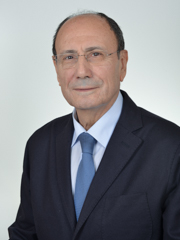
Renato Schifani
Renato Schifani is an Italian politician who serves as the President of the Sicilian Region. He has been active in regional politics for many years and is known for his focus on issues affecting Sicily, including tourism and safety measures in light of natural disasters such as the recent volcanic activity of Mount Etna.
Born on Jan 01, 1950 (75 years old)
Global Media Ratings
Countries Mentioned
No country-level mention data available.
Interactive World Map
Each country's color is based on "Mentions" from the table above.
Recent Mentions
 Italy:
Renato Schifani is the governor of Sicily, who has been targeted by Carlo Calenda during a visit to Palermo.
4
Italy:
Renato Schifani is the governor of Sicily, who has been targeted by Carlo Calenda during a visit to Palermo.
4
 Italy:
Renato Schifani has expressed clear support regarding the Ponte sullo Stretto project.
6
Italy:
Renato Schifani has expressed clear support regarding the Ponte sullo Stretto project.
6
 Croatia:
Renato Schifani is the president of the region who participated in the funeral of Paolo Taormina.
5
Croatia:
Renato Schifani is the president of the region who participated in the funeral of Paolo Taormina.
5
 Italy:
Renato Schifani is the governor of Sicily and has been in office since 2022.
8
Italy:
Renato Schifani is the governor of Sicily and has been in office since 2022.
8
 Italy:
Renato Schifani is the governor of the Region who issued an ultimatum to remove obstacles limiting beach access.
8
Italy:
Renato Schifani is the governor of the Region who issued an ultimatum to remove obstacles limiting beach access.
8
 Italy:
Renato Schifani expressed his desire for the Ponte sullo Stretto to be named after Silvio Berlusconi.
7
Italy:
Renato Schifani expressed his desire for the Ponte sullo Stretto to be named after Silvio Berlusconi.
7
 Italy:
Renato Schifani is the president of Sicily who announced the tax cuts to attract investments.
8
Italy:
Renato Schifani is the president of Sicily who announced the tax cuts to attract investments.
8
 Italy:
Renato Schifani, the president of the Region, has accelerated efforts regarding desalination plants in Sicily.
6
Italy:
Renato Schifani, the president of the Region, has accelerated efforts regarding desalination plants in Sicily.
6
 Italy:
Renato Schifani blocked the participation of the Sicilian region in the Cannes Festival due to excessive costs.
5
Italy:
Renato Schifani blocked the participation of the Sicilian region in the Cannes Festival due to excessive costs.
5
 United Arab Emirates:
Renato Schifani is the President of the Sicily region.
7
United Arab Emirates:
Renato Schifani is the President of the Sicily region.
7